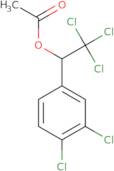Informazioni sul prodotto
- 1-(3,4-Dichlorophenyl)-2,2,2-trichloroethyl acetate
- 2,2,2-Trichloro-1-(3,4-Dichlorophenyl)Ethyl Acetate
- 2,2,2-Trichloro-1-(3,4-dichlorophenyl)ethanol acetate
- 3,4-Dichloro-alpha-(trichloromethyl)benzenemethyl acetate
- 3,4-Dichloro-alpha-(trichloromethyl)benzyl acetate
- Acetofenate
- Ai3-29252
- BAY meb 6046
- Baygon MEB
- Benzenemethanol, 3,4-dichloro-alpha-(trichloromethyl)-, acetate
- Vedi altri sinonimi
- Benzenemethanol, 3,4-dichloro-α-(trichloromethyl)-, 1-acetate
- Benzenemethanol, 3,4-dichloro-α-(trichloromethyl)-, acetate
- Benzyl alcohol, 3,4-dichloro-alpha-(trichloromethyl)-, acetate
- Benzyl alcohol, 3,4-dichloro-α-(trichloromethyl)-, acetate
- Brn 2466230
- Ethanol, 1-(3,4-dichlorophenyl)-2,2,2-trichloro-, acetate
- Mb 6046
- Meb-6046
- Penfenate
- Plifenate
- β,β,β-Trichloro-α-(3,4-dichlorophenyl)ethanol acetate
- β,β,β-Trichloro-α-(3,4-dichlorophenyl)ethyl acetate
- 4-06-00-03052 (Beilstein Handbook Reference)
Acetofenate is a salt of anhydrous sodium acetate and sodium carbonate. It has been shown to have high resistance against mollusca, but low resistance against insects. Acetofenate has been used in vitro assays to study the reaction mechanism of fatty acid esterification. Acetofenate reacts with acetic acid or alcohols to form esters, which are then hydrolyzed by enzymes such as lipases, esterases, and phospholipases. Acetofenate is also used as a food additive to prevent spoilage of fats and oils.





